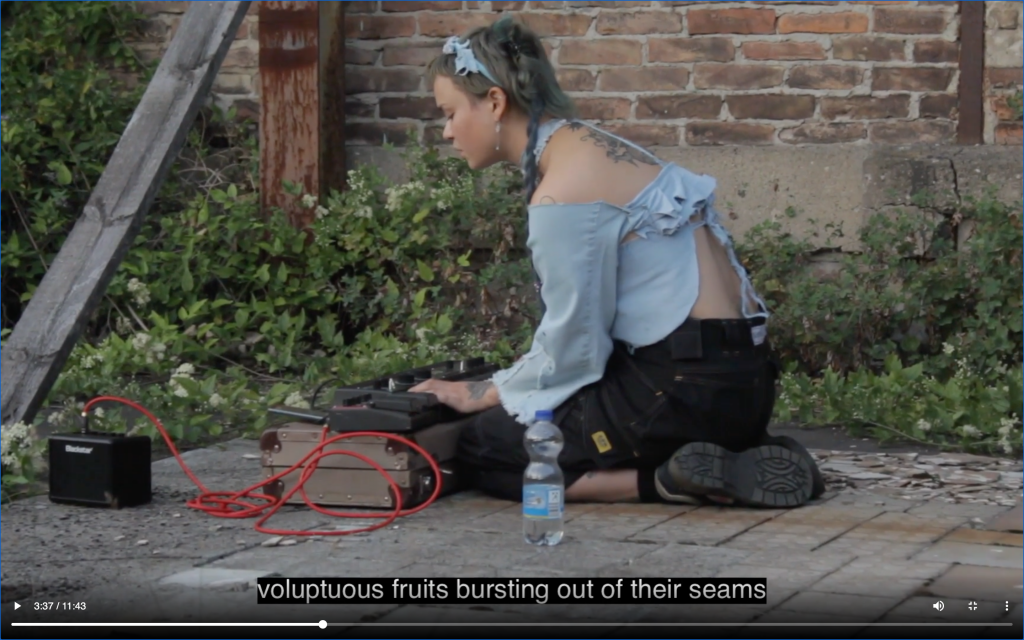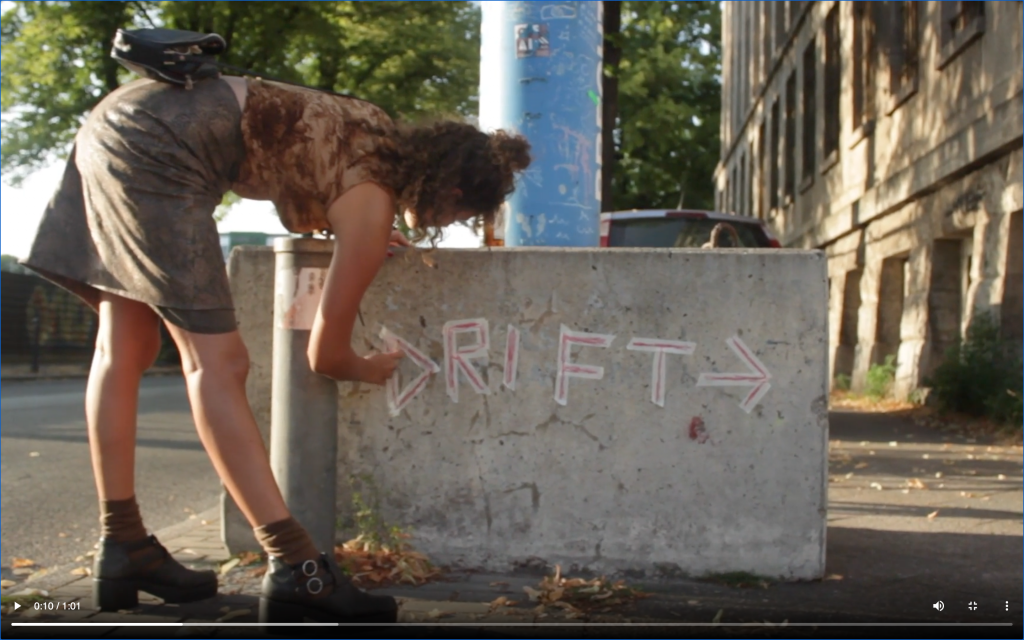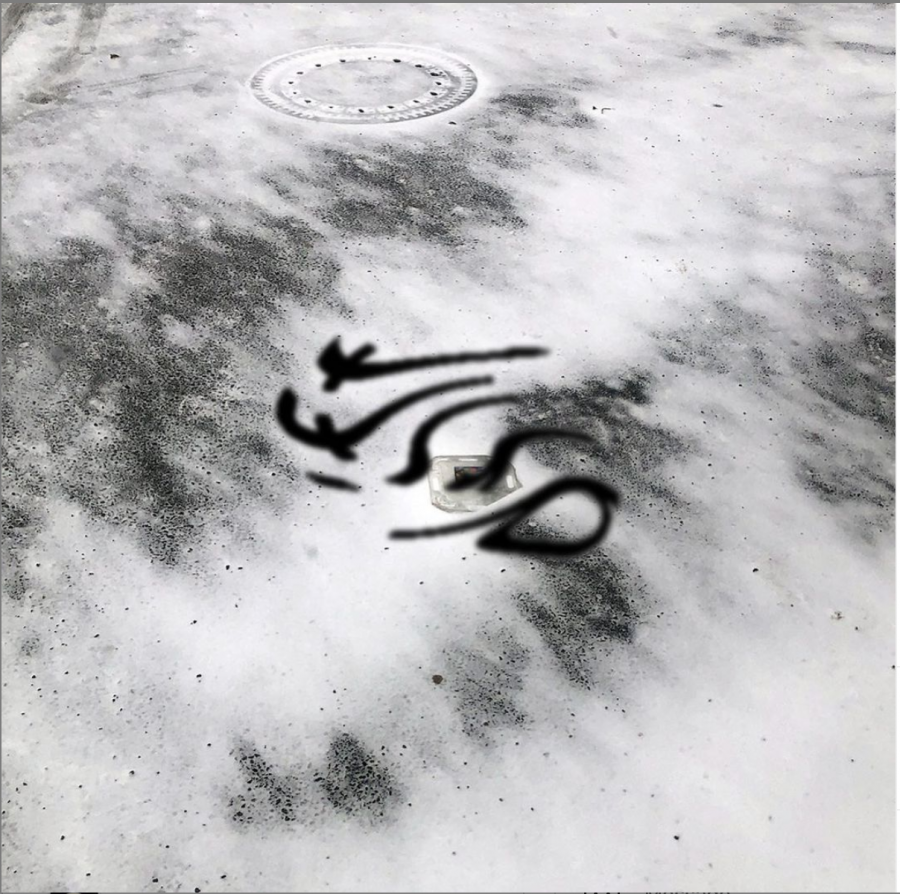cherub henry and Sam Harper moved to Berlin from New Zealand via London almost eight years ago. They now both study under Hito Steyerl at Berlin’s University of the Arts. cherub also works as a sex worker. In the summer of 2019, Sam and cherub founded a series of text-based performances called drift. drift is an ongoing series of text based performances; each event meets in a new location, and a varying number of people perform, sometimes with music, sometimes with video, sometimes with other performers. The performances are then carefully archived on drift’s website: their instagram bio reads, “Staging and archiving contemporary thought through reading and performance.”
I met with Sam Harper around Kottbusser Tor – It was finally warm enough to meet with friends outside. We talked about the inspiration and purpose behind the series, about technophobia, and about creating exhibition spaces and platforms for our immediate communities.
Tell me about your inspiration for drift.
The inspiration for drift came from a reading that Australian writer and author Holly Childs gave at the gallery Trust. She used music and a projector in order to enhance the experience of what she was reading. All summer I had attended more conventional readings, but after this reading, I wanted to find a way of enhancing text-based performance into more of a multimedia experience.
So what’s your artistic background?
My background is of a media artist and a writer and I work with video and animation and sound and text in one big conglomerate to say a single thing, to unify it into a single piece.
It makes sense, then, that you’d be inspired to do something like this. I’ve been to the drift performances, and most of them are in English, but there’s also reading in German. What do you think about this dichotomy as a Native English speaker in Berlin, where English has taken over a huge part of the culture?
To be honest, there’s only been English and German so far, but in drift we’ve always wanted performances in other languages too, because even if the audience doesn’t cerebrally understand the words that are being said, they hear tone, and hear emotion in a language.
It’s almost the musical quality of the language.
Exactly.
Even if the audience doesn’t understand the words, they can understand the performance.
I think that in the future we also want to de-anglify the art world as best we can in Berlin, because many people speak very good English but they also have mother tongues. We almost want to make it more inaccessible to the English and German speakers at times, who have it very easy, and to give some space to people who speak other languages.
It’s one of the only ways that English and German speakers here would experience what it’s like for many others, where art events are often only in these two languages. It’s also interesting to explore language for its musical qualities and the performance itself.
I think a big part of that is looking outside of text as an understanding of the written word and pushing it into something else. Text can be written music – anything – and it doesn’t have to be about what it conveys.
In that way it can be a visual thing. When Holly Childs did the reading at Trust that you referenced earlier, she projected herself live-editing the text that she read. This makes sense: so much of our practice as writers is typing off-hand things into our phone notes, then we go through the process of collecting, refining, editing these thoughts, in the same way that she performed live.
A huge part of drift is work that’s in progress, too. Holly Childs’ piece was literally in progress, but we also want to have a lot of work that’s not even experimental but just unfinished. There’s so many nice raw qualities in unfinished work, especially when it comes to writing. It’s worth creating a space for the raw qualities too.
We’re also so intimate with our technology. It reminds me of when Berlin-based musician Holly Herndon writes about the laptop being the most intimate instrument because it has everything about us on it – recordings of our voices, texts from our mom, photos of our family and lovers and friends – so writing on our devices and then exposing that technology to others as a performance is really vulnerable.
You’re also capturing the portability of someone’s creative experience: they’re on the train, then at work, and you don’t necessarily in a different era have your notebook and pen with you all the time –
But we always have our phones – It’s like our extension.
Exactly. And so we are constantly creating a data set. It’s interesting to get a lot of data sets together and compare those in themselves.
Data itself is another kind of text – the script that writes all of our technology, but one that we wouldn’t read or experience as language as we know it. All the text performances that are enhanced with technology have script behind them – so there’s layers of text.
I was actually thinking about data today and how it has a lack of chronology – it’s abstract. We interpret it in a chronological form, and although it’s very ordered, it’s not a beginning to an end, not chronological in nature. I was trying to download Caliban and the Witch onto my iPad, and it was taking a long time, and I really only wanted to read the first ten pages on the train, but I knew that if I paused it, I wouldn’t be able to read anything because it hadn’t downloaded from page 1 to wherever.
There’s a myth at the moment that people are reading less because we’re such a visual culture – but it is really a myth – more books are being purchased than ever before – although of course we buy books and download PDFs and don’t read them, but still. There’s a feeling among writers, that we have to push past text on the page. I think of Canadian classicist and poet Anne Carson: she now primarily gives readings, performances; you can watch her on YouTube giving these performances, but not buy these texts. Do you think moving away from reading alone was an influence in starting drift, and wanting it to be mixed media? Does writing have to be more relevant?
No, I don’t think it’s a project of making writing relevant. I think it’s a different interpretation of what writing can be. There is still so much space for the book in book form, because it’s such an important, concise way of getting so much thought into a direct stream. I think print, in some ways, might have its days numbered, but we as people are consuming more text-based information than ever before.
Whether it’s printed or digitized.
Yes. It could be that we’re in a transitory phase between these two mediums, and that we’ll start to read long form things on our devices. But, still, personally I don’t foresee that people will stop buying books. There’s just more options now; being a book-buyer means more than one thing.
How do you choose artists for drift? You’ve chosen your friends, you’ve chosen established writers; in the last drift, for example, you actually invited Holly Childs, the inspiration for this series. How do you go about selecting artists?
We think it’s really important that people who don’t have a CV or who the art world doesn’t consider to be successful yet have the opportunity to work with people who are considered to already have a measure of success. We try to blend them. Then we have a wishlist of future participants – a huge wishlist! – and we find out who is available when. Someone also once said that drift is a project for friends and lovers, and that’s very true.
It’s important for us to give people from our own direct community a space to perform, because a lot of these artists don’t consider themselves to be writers, so entering into a foreign space to exhibit – that might be too much of a step for them to take themselves.
Yes, even submitting one’s work is sometimes too intimidating.
We want a place where everyone can be experimental.
I also love the different genres. For example, in the most recent performance, there was fictional narrative poetry, and then the next one was almost a journal entry, reflective on that person’s life, totally truthful.
We don’t actually vet anyone’s writing. It’s always coincidence and happenstance the way things end up working cohesively. Cohesive, but with a very varied range of what the audience will see.
Speaking of cohesiveness: one of the reasons the series is called drift, is that every performance is in a different space, and not only in a gallery. I’ve been to one online because of corona, one in a rose garden, one in an abandoned chicken factory, to name a few. I love this – it gets rid of the hierarchy of needing a gallery space: a park filled with roses or an empty lot is just as legitimate a space for experiment and performance as more well-known galleries where you’ve also met, like Horse and Pony. This encourages us to create our own spaces – we don’t need permission.
Yeah – we’ve done some in established spaces, and then some more rogue ones – and I think the ever-changing location is important so we don’t get tied to a particular scene or gallery.
You don’t want to make it fashionable.
Exactly. There’s always new people at each one. It’s important to have events that are outside the constraints of the art world, because there’s so much pressure to conform there, especially in Berlin.
There’s also not an obsession about cohesiveness in your social media.
We leave it completely up to the artists to have autonomy over their own image.
That is of course more realistic to what the internet is like. When technology is represented as only sleek, like we live in a sleek era, I think it’s comical. It’s pretend, because our technology is endless variation and clutter, on our computer, our apps, on the internet. This leads to another thing I want to discuss: the archiving of all the drift performances.
We like to put an emphasis on filming, on documenting the performances really well. So many readings are horribly filmed: one static camera at the front, recording audio from the camera, etc.
It’s this weird habitual bitterness towards technology.
It’s technophobia. A well-made archive of the performance can enhance what’s being said.
And the artists deserve it – to preserve the work nicely is to respect it.
Exactly. It’s also a document for them, and then good for us to show what we do.
Going back to the technophobia within the literature community, I wonder if it comes from a desire for authenticity. People are afraid that technology is inauthentic.
But it’s naive to assume that technology and authenticity contradict one another. Our online self has become our authentic self.
As evening drew near, our conversation turned to the dropping temperature. I thanked Sam for the interview and we walked back towards the train station, wondering aloud how our current pandemic isolation, our ever-stronger online identities, and our need for new community structures would play into future formation of our own art and literature worlds. The next drift will be a socially-distanced walk; keep an eye on the website for new announcements.




